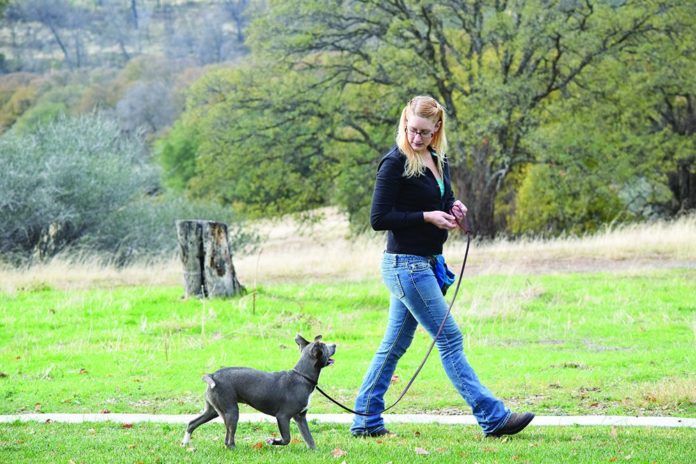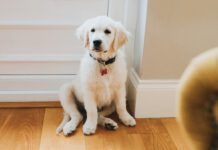Did you know that the best way to teach a puppy to walk politely on a leash is to not use a leash? If you think that sounds like an inscrutable Buddhist koan, fear not – you are not alone. It’s far more common to see people either dragging their puppies around, or being dragged around by their puppies, than it is to see a calm, happy puppy trotting along by her owner’s side.
A lot of people seem to have the misconception that a leash is a handle for pulling your dog wherever you want him to go – or for him to pull you! The evidence for this starts in puppyhood, when you see the reluctant (often tired or scared) baby dog being tugged along behind the human who is intent on getting somewhere faster than the puppy can, or wants to. The leash, they believe, is supposed to make the puppy come along, regardless.
They couldn’t be more wrong. The true function of a leash is simply to keep the puppy from leaving. The motivation to get the pup to walk happily alongside you should come from you! The challenge, then, is to teach your pup to walk with you without a leash – and it’s actually much easier than you might think. Here’s how:
1. In a low-distraction, safely enclosed environment, equipped with plenty of treats, a squeaky toy, and/or a tug toy in your pocket, engage your off-leash pup by talking happily to him and feeding him a treat.
2. With your treat hand hidden behind your back, take a step, cheerfully inviting your puppy to come with you. When he does, “mark” this desired behavior with the click! of a clicker or a verbal marker (such as the word, “Yes!”), and give him a treat.
3. Now take another step, and click and treat when he comes with you.
4. Gradually increase the number of steps you take, remembering to use variable reinforcement. That is, sometimes you give him a treat after several steps, and sometimes after one or two steps, to keep him guessing – and enthusiastic.
5. Make it a fun game. Take bouncy steps. Use a happy voice. Sometimes reinforce with a squeaky toy or a game of tug instead of treats. Make yourself the most fun, interesting, and reinforcing thing in the room so he chooses to stay close to you.
6. When your puppy is a rock star at walking with you without a leash, attach the leash to his collar but don’t change anything else. Keep practicing your fun-walk games. If at any time the leash tightens, resist the temptation to pull him toward you – just stop, happily engage him, wait until he loosens the leash by coming toward you, and walk again.
7. Now you’re ready to fun-walk with your pup in more distracting environments – i.e., the real world. Take higher-value treats and more-enticing toys if necessary, but always remember it’s our job as the supposedly more intelligent species to get our dogs to want to do what we want them to, including walking with us, rather than forcing them to do it.
Come When Called
The same procedure works for teaching your pup to come when called. I shudder when I think of the way we used to teach it in old-fashioned obedience classes: Leave your dog on a sit stay, walk to the end of the leash, then call your dog and jerk on the leash to teach him to come quickly in order to avoid being yanked off his feet. Talk about giving a negative association with the word, “Come!” No wonder so many dogs got “leash-wise” and refused to come when they were called in wide-open spaces.
Instead, teach your pup the fun-come game, in the same way as the fun-walk game. With high-value treats and enticing toys, convince your pup that the word “Come” means “You better get over here, because we’re about to have the most fun ever!” Get in the habit of running away from your pup when you call him to take advantage of his natural response to chase things that move, incorporated with treats and games when he gets to you, and you’ve got a sure winner!
In fact, if you apply this fun-training philosophy to everything you teach your pup, you may be amazed at your training success. Dogs are fun-lovers, and this engaging, rewarding approach will preserve your dog’s interest in working with you on any training project.
Pat Miller, CBCC-KA, CPDT-KA, is WDJ’s Training Editor. She lives in Fairplay, Maryland, site of her Peaceable Paws training center, where she offers dog-training classes and courses for trainers.






